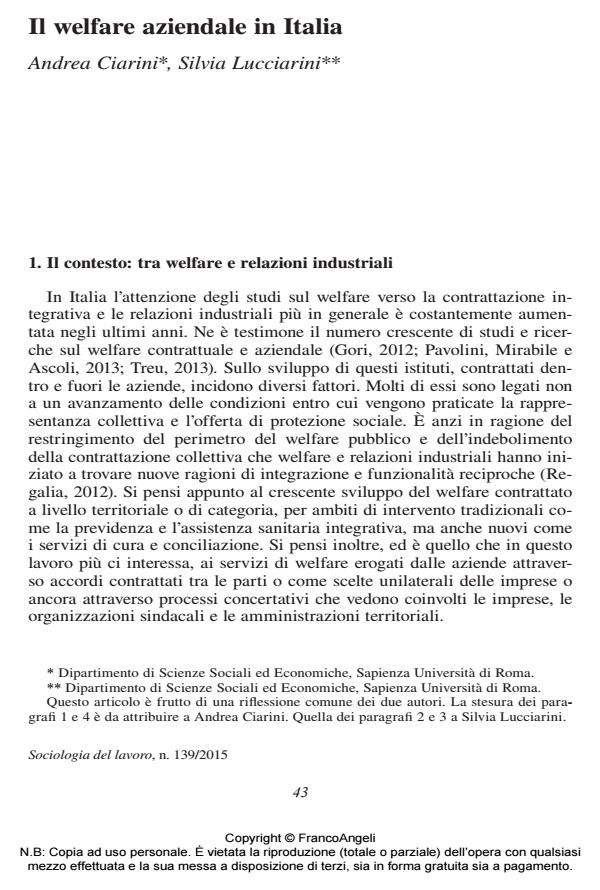The company welfare in Italy
Journal title SOCIOLOGIA DEL LAVORO
Author/s Andrea Ciarini, Silvia Lucciarini
Publishing Year 2015 Issue 2015/139
Language Italian Pages 13 P. 43-55 File size 131 KB
DOI 10.3280/SL2015-139004
DOI is like a bar code for intellectual property: to have more infomation
click here
Below, you can see the article first page
If you want to buy this article in PDF format, you can do it, following the instructions to buy download credits

FrancoAngeli is member of Publishers International Linking Association, Inc (PILA), a not-for-profit association which run the CrossRef service enabling links to and from online scholarly content.
The article contributes to the analyses of complementary welfare measures that tend to operate at the company level. The company welfare schemes are found mainly in medium-large businesses and are primarily aimed at the employees who are already covered by the ordinary welfare institutions. They comprise a wide range of complementary services: healthcare, social assistance, work-life balance schemes. Though already present in Italy, these kinds of services have been expanding in the last few years either as a result of unilateral choices on the part of companies or as part of agreements made between companies and unions. The aim of this paper is to address these issues, by considering the EdenRed database, which allowed a detailed examination of these services at territorial level.
Keywords: Company welfare, industrial relations, labour market
- Agostini C., Ascoli U. (2014). Il welfare occupazionale: un’occasione per la ricalibratura del modello italiano? Politiche Sociali, 2: 263-279. DOI: 10.7389/7734
- Burroni L., Carrieri M. (2011). Bargaining for social rights. (BARSORI) country report Italy, Burroni L., Pedaci M. (2014). Collective Bargaining, Atypical Employment and Welfare Provisions: The Case of Temporary Agency Work in Italy. Stato e Mercato, 2: 169-194 DOI: 10.1425/7741
- Burroni L., Ramella F. (2015). Negoziare, Regolare e Promuovere lo Sviluppo Locale. Rivista Giuridica del Lavoro, 1: 49-63.
- Carrieri M., Treu T., a cura di (2013). Verso nuove relazioni industriali. Bologna: il Mulino.
- Ferrera M., Maino F. (2013). Primo Rapporto Sul Secondo Welfare In Italia, Percorsi di secondo welfare.
- Gori C. (2012). L’alternativa al pubblico? Milano: FrancoAngeli Leonardi S., Arlotti M. (2012). Welfare contrattuale e bilateralismo. La Rivista delle Politiche Sociali, 3: 77-114.
- Mallone G. (2013). Il secondo welfare in Italia: esperienze di welfare aziendale a confronto, Working paper, Percorsi di secondo welfare - Centro Einaudi Pavolini E.
- Carrera F. (2013). I tratti del welfare occupazionale a partire dalle indagini quantitative. In: Pavolini E., Mirabile M.L., Ascoli U., a cura di, Tempi moderni. Il welfare nelle aziende in Italia. Bologna: il Mulino.
- Pavolini E., Mirabile M.L., Ascoli U., a cura di (2013). Tempi moderni. Il welfare nelle aziende in Italia. Bologna: il Mulino.
- Regalia I. (2012). La protezione sociale del lavoro come tema delle relazioni industriali. La Rivista delle Politiche Sociali, 3: 13-36.
- Reyneri E., Pintaldi L. (2013). Dieci domande su un mercato del lavoro. Bologna: il Mulino.
- Treu T. (2013). Welfare aziendale. Roma: Ipsoa.
- Il benessere familiare tra i Working Carer che usano misure di Familyaudit Elena Macchioni, Matteo Orlandini, Valerio Vanelli, in SOCIOLOGIA E POLITICHE SOCIALI 3/2018 pp.73
DOI: 10.3280/SP2017-003005 - Il disagio socio-economico delle famiglie italiane fra diritti e (in)giustizia. Il "nuovo" ruolo del Servizio Sociale oggi e le sfide del futuro Davide Barba, Mariangela D’Ambrosio, in SICUREZZA E SCIENZE SOCIALI 3/2024 pp.143
DOI: 10.3280/SISS2023-003010 - Le opportunità di conciliazione cura-lavoro nelle regioni italiane tra circoli virtuosi e viziosi Alessandra Fasano, Silvia Lucciarini, in SOCIOLOGIA E POLITICHE SOCIALI 2/2015 pp.172
DOI: 10.3280/SP2015-002009
Andrea Ciarini, Silvia Lucciarini, Il welfare aziendale in Italia in "SOCIOLOGIA DEL LAVORO " 139/2015, pp 43-55, DOI: 10.3280/SL2015-139004